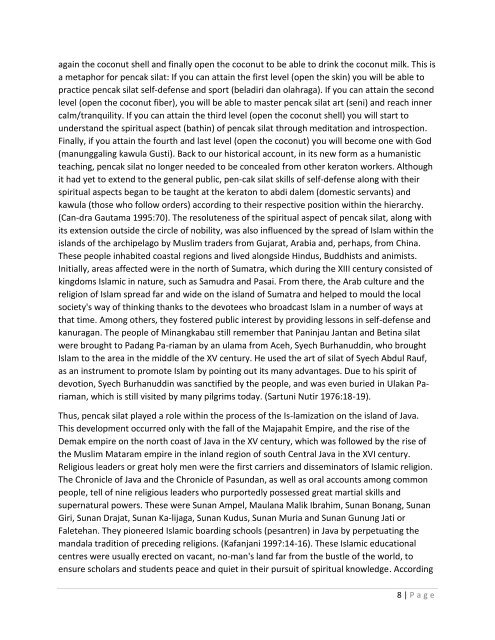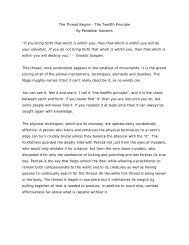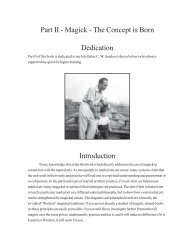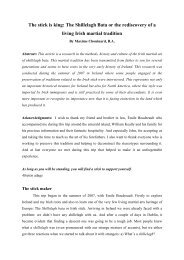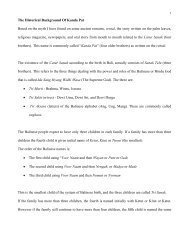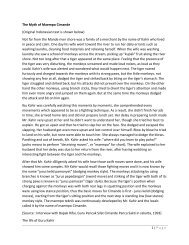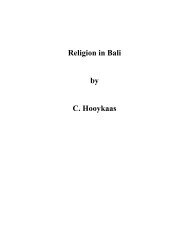Biography of Bapak O'ong Maryono He was born on July 28, 1953 in ...
Biography of Bapak O'ong Maryono He was born on July 28, 1953 in ...
Biography of Bapak O'ong Maryono He was born on July 28, 1953 in ...
Create successful ePaper yourself
Turn your PDF publications into a flip-book with our unique Google optimized e-Paper software.
aga<strong>in</strong> the coc<strong>on</strong>ut shell and f<strong>in</strong>ally open the coc<strong>on</strong>ut to be able to dr<strong>in</strong>k the coc<strong>on</strong>ut milk. This is<br />
a metaphor for pencak silat: If you can atta<strong>in</strong> the first level (open the sk<strong>in</strong>) you will be able to<br />
practice pencak silat self-defense and sport (beladiri dan olahraga). If you can atta<strong>in</strong> the sec<strong>on</strong>d<br />
level (open the coc<strong>on</strong>ut fiber), you will be able to master pencak silat art (seni) and reach <strong>in</strong>ner<br />
calm/tranquility. If you can atta<strong>in</strong> the third level (open the coc<strong>on</strong>ut shell) you will start to<br />
understand the spiritual aspect (bath<strong>in</strong>) <str<strong>on</strong>g>of</str<strong>on</strong>g> pencak silat through meditati<strong>on</strong> and <strong>in</strong>trospecti<strong>on</strong>.<br />
F<strong>in</strong>ally, if you atta<strong>in</strong> the fourth and last level (open the coc<strong>on</strong>ut) you will become <strong>on</strong>e with God<br />
(manunggal<strong>in</strong>g kawula Gusti). Back to our historical account, <strong>in</strong> its new form as a humanistic<br />
teach<strong>in</strong>g, pencak silat no l<strong>on</strong>ger needed to be c<strong>on</strong>cealed from other kerat<strong>on</strong> workers. Although<br />
it had yet to extend to the general public, pen-cak silat skills <str<strong>on</strong>g>of</str<strong>on</strong>g> self-defense al<strong>on</strong>g with their<br />
spiritual aspects began to be taught at the kerat<strong>on</strong> to abdi dalem (domestic servants) and<br />
kawula (those who follow orders) accord<strong>in</strong>g to their respective positi<strong>on</strong> with<strong>in</strong> the hierarchy.<br />
(Can-dra Gautama 1995:70). The resoluteness <str<strong>on</strong>g>of</str<strong>on</strong>g> the spiritual aspect <str<strong>on</strong>g>of</str<strong>on</strong>g> pencak silat, al<strong>on</strong>g with<br />
its extensi<strong>on</strong> outside the circle <str<strong>on</strong>g>of</str<strong>on</strong>g> nobility, <str<strong>on</strong>g>was</str<strong>on</strong>g> also <strong>in</strong>fluenced by the spread <str<strong>on</strong>g>of</str<strong>on</strong>g> Islam with<strong>in</strong> the<br />
islands <str<strong>on</strong>g>of</str<strong>on</strong>g> the archipelago by Muslim traders from Gujarat, Arabia and, perhaps, from Ch<strong>in</strong>a.<br />
These people <strong>in</strong>habited coastal regi<strong>on</strong>s and lived al<strong>on</strong>gside H<strong>in</strong>dus, Buddhists and animists.<br />
Initially, areas affected were <strong>in</strong> the north <str<strong>on</strong>g>of</str<strong>on</strong>g> Sumatra, which dur<strong>in</strong>g the XIII century c<strong>on</strong>sisted <str<strong>on</strong>g>of</str<strong>on</strong>g><br />
k<strong>in</strong>gdoms Islamic <strong>in</strong> nature, such as Samudra and Pasai. From there, the Arab culture and the<br />
religi<strong>on</strong> <str<strong>on</strong>g>of</str<strong>on</strong>g> Islam spread far and wide <strong>on</strong> the island <str<strong>on</strong>g>of</str<strong>on</strong>g> Sumatra and helped to mould the local<br />
society's way <str<strong>on</strong>g>of</str<strong>on</strong>g> th<strong>in</strong>k<strong>in</strong>g thanks to the devotees who broadcast Islam <strong>in</strong> a number <str<strong>on</strong>g>of</str<strong>on</strong>g> ways at<br />
that time. Am<strong>on</strong>g others, they fostered public <strong>in</strong>terest by provid<strong>in</strong>g less<strong>on</strong>s <strong>in</strong> self-defense and<br />
kanuragan. The people <str<strong>on</strong>g>of</str<strong>on</strong>g> M<strong>in</strong>angkabau still remember that Pan<strong>in</strong>jau Jantan and Bet<strong>in</strong>a silat<br />
were brought to Padang Pa-riaman by an ulama from Aceh, Syech Burhanudd<strong>in</strong>, who brought<br />
Islam to the area <strong>in</strong> the middle <str<strong>on</strong>g>of</str<strong>on</strong>g> the XV century. <str<strong>on</strong>g>He</str<strong>on</strong>g> used the art <str<strong>on</strong>g>of</str<strong>on</strong>g> silat <str<strong>on</strong>g>of</str<strong>on</strong>g> Syech Abdul Rauf,<br />
as an <strong>in</strong>strument to promote Islam by po<strong>in</strong>t<strong>in</strong>g out its many advantages. Due to his spirit <str<strong>on</strong>g>of</str<strong>on</strong>g><br />
devoti<strong>on</strong>, Syech Burhanudd<strong>in</strong> <str<strong>on</strong>g>was</str<strong>on</strong>g> sanctified by the people, and <str<strong>on</strong>g>was</str<strong>on</strong>g> even buried <strong>in</strong> Ulakan Pariaman,<br />
which is still visited by many pilgrims today. (Sartuni Nutir 1976:18-19).<br />
Thus, pencak silat played a role with<strong>in</strong> the process <str<strong>on</strong>g>of</str<strong>on</strong>g> the Is-lamizati<strong>on</strong> <strong>on</strong> the island <str<strong>on</strong>g>of</str<strong>on</strong>g> Java.<br />
This development occurred <strong>on</strong>ly with the fall <str<strong>on</strong>g>of</str<strong>on</strong>g> the Majapahit Empire, and the rise <str<strong>on</strong>g>of</str<strong>on</strong>g> the<br />
Demak empire <strong>on</strong> the north coast <str<strong>on</strong>g>of</str<strong>on</strong>g> Java <strong>in</strong> the XV century, which <str<strong>on</strong>g>was</str<strong>on</strong>g> followed by the rise <str<strong>on</strong>g>of</str<strong>on</strong>g><br />
the Muslim Mataram empire <strong>in</strong> the <strong>in</strong>land regi<strong>on</strong> <str<strong>on</strong>g>of</str<strong>on</strong>g> south Central Java <strong>in</strong> the XVI century.<br />
Religious leaders or great holy men were the first carriers and dissem<strong>in</strong>ators <str<strong>on</strong>g>of</str<strong>on</strong>g> Islamic religi<strong>on</strong>.<br />
The Chr<strong>on</strong>icle <str<strong>on</strong>g>of</str<strong>on</strong>g> Java and the Chr<strong>on</strong>icle <str<strong>on</strong>g>of</str<strong>on</strong>g> Pasundan, as well as oral accounts am<strong>on</strong>g comm<strong>on</strong><br />
people, tell <str<strong>on</strong>g>of</str<strong>on</strong>g> n<strong>in</strong>e religious leaders who purportedly possessed great martial skills and<br />
supernatural powers. These were Sunan Ampel, Maulana Malik Ibrahim, Sunan B<strong>on</strong>ang, Sunan<br />
Giri, Sunan Drajat, Sunan Ka-lijaga, Sunan Kudus, Sunan Muria and Sunan Gunung Jati or<br />
Faletehan. They pi<strong>on</strong>eered Islamic board<strong>in</strong>g schools (pesantren) <strong>in</strong> Java by perpetuat<strong>in</strong>g the<br />
mandala traditi<strong>on</strong> <str<strong>on</strong>g>of</str<strong>on</strong>g> preced<strong>in</strong>g religi<strong>on</strong>s. (Kafanjani 199?:14-16). These Islamic educati<strong>on</strong>al<br />
centres were usually erected <strong>on</strong> vacant, no-man's land far from the bustle <str<strong>on</strong>g>of</str<strong>on</strong>g> the world, to<br />
ensure scholars and students peace and quiet <strong>in</strong> their pursuit <str<strong>on</strong>g>of</str<strong>on</strong>g> spiritual knowledge. Accord<strong>in</strong>g<br />
8 | P a g e


